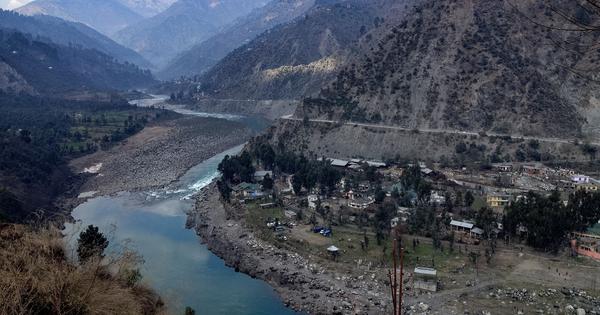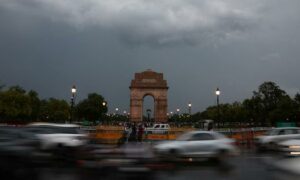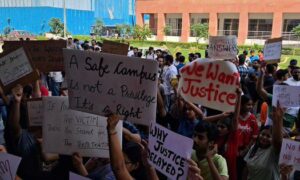
The Chandrabhaga Lake is a wide and large water body in Assar village, extending till Dharmound in Ramban district. The stagnant water resembles a frozen bowl of basil-green soup. Situated on the left bank of the river, Assar, with its fertile agricultural fields, is called “the vegetable basket” of the Chenab Valley. Apart from the luxuriant fields of maize and wheat, nearly twenty varieties of vegetables are grown here.
The vegetable production as a commercial crop came to Assar in 1960, when a West Pakistan refugee (WPR) named Mulkh Raj came to the village. He distributed seeds and fertilisers to the farmers and encouraged vegetable production. However, this started the circle of exploitation of the small growers, as Mulkh Raj would become the first commission agent, an intermediary between the farmers of Assar and the markets of Jammu.
The system of commission agents became stronger over the years, making the grower poorer and the wholesale merchant and agent richer. The vegetables, if not sold in time, would rot, giving no choice to the farmers but to sell at whatever low price they were offered. “You will be left with no choice but to throw your vegetables in the Chenab,” the commission agents would warn them. Aware of the exploitation, the farmers of Assar have been demanding for cold storage to escape the sinister clutches of the commission agents and traders who push them into distress sales.
A ring of villages across the Chenab also grows vegetables for commercial purposes. These villages are connected with Assar through a cradle box. In 1988, a great tragedy occurred here when an army aviation helicopter, presumably flying too low, hit the cable of the cradle box. The machine crashed and plunged into the Chenab, taking two pilots along with it. The rescue operation started with the local divers, but they were unable to find even a tiny part of the helicopter, let alone the pilots. The navy divers summoned from Bombay, with all their paraphernalia and expertise, scoured the river depths but returned empty-handed. After ten days, they gave up, having searched a great area in the river waters. A month later, the rotting corpse of one of the pilots was recovered from Salal Hydroelectricity Project in Reasi.
Road traffic accidents on the Kishtwar–Batote road have been common. Many a times a whole bus plunges down the river, killing dozens, destroying families and clans. The surety of death is perceived as a foregone conclusion each time a vehicle comes in contact with the water of the Chenab. In December 2022, an Alto car rolled down from the highway and plunged into the Chenab. On the bank of the river, two identity cards, a driving license and a purse were found. The car was retrieved from the river, but there was no trace of any luggage or the occupants of the car. Police investigation identified Manjeet Singh, a small-time contractor from Bhaderwah and his wife and six-year-old daughter as the occupants of the ill-fated vehicle. In no time, the smiling photograph of the young couple with their cute daughter in pigtails found its way on social media. A plethora of heartfelt comments and condolences poured in for the family. Some netizens even cursed the Chenab for having yet again gulped innocent souls.
The police continued to look for the bodies and investigate the case. It was later found that Manjeet Singh was under heavy debt as he had taken a loan of Rs 30 lakh from different banks and private lenders. Unable to pay the debts, he staged the accident. Twenty days later, the family was traced in Panchkula, Haryana, where they had been living with changed identities.
The Chenab moves forward from the lake and passes underneath Dharmound. Soon appears the panoramic view of the river flowing by the bowl of Chanderkote on one side and the Chandrabhaga lake on the other. Meanwhile, just behind the river, the pine forests seem to climb up a mountain, ensconcing the highway town of Batote in nature’s green lap.
There are a large number of Sikhs residing in Batote. The first batch arrived with Sant Rocha Singh. Rocha Singh was born to Brahmin parents in Pakistan. He was barely fourteen years old when his father died, leaving him in the care of his mother and younger brother. The tall and handsome Rocha Singh chanced to meet Guru Gobind Singh in 1705. That meeting changed him forever. He spent the rest of his life in the company of saints. For his dedication, Rocha Singh was taken into the Khalsa fold, and it is presumed that he travelled all over Jammu and Kashmir to spread the message of Sikhism. More Sikhs settled in Batote, escaping the communal frenzy of 1947. A gurudwara in the town, erected in the memory of Sant Rocha Singh, is a place for pilgrimage.
Nestled amidst green hills, Batote is famous for its natural beauty and exotic migratory birds. Due to its salubrious environs, blessed with pleasant weather and fresh air, it is also considered to be a natural health resort.
In the 1930s, the Batote Hospital became a recuperating centre for patients of tuberculosis. The hospital, located amidst a copse of pine trees, was considered to be a perfect spot for rejuvenation.
In 1935, Saadat Hasan Manto was admitted here. Manto, with his paternal roots in Kashmir and maternal lineage in Afghanistan, was born in Ludhiana in 1912 into a family of legal luminaries. In 1934, he joined the Aligarh Muslim University to pursue graduation. However, his education at the university was cut short as he was diagnosed with tuberculosis. He spent three months for his treatment in the Batote sanatorium. After regaining his health in the healing surroundings, Manto returned home. Undoubtedly, the fresh breeze blowing across the pines on the Chenab’s banks played its role. There is nothing to prove if his stay in Batote influenced his writing or not, but he eventually became one of the finest writers in the Urdu language and matured into a celebrated playwright, artistic essayist and a story-writer.
On an early morning in September 2019, not far from the sanatorium, gunfire and explosions shattered the peace of Batote. Even during the peak of militancy in the Chenab Valley, Batote had largely remained peaceful. However, being situated on the highway, it has been a transit point for the militants entering surreptitiously into Jammu city or moving towards the Kashmir Valley. Earlier in the day, a group of three terrorists had emerged from the forests on the Doda-Batote highway. Two of them hid behind the trees and took positions while the third came on the road and signalled a vehicle to stop. The driver of the vehicle, displaying great presence of mind, sped away. On the way, he saw an army vehicle and informed them about the armed militant on the roadside. When the army vehicle approached the spot, it came under heavy fire. In a short time, enforcements arrived and the hot pursuit of the terrorists began.
After a few hours, the terrorists were spotted in the lower part of Batote town, hiding near the quarters of the GREF. On seeing a Territorial Army patrol passing by, the militants panicked, threw grenades and escaped further up in a locality of clustered houses. They climbed up the stairs of a randomly chosen house and forcibly entered inside. The house belonged to a local tailor, and the militants took his family hostage.
The security forces cordoned off the house and plugged all exit routes. The terrorists released the women but kept the tailor captive. Frenetic appeals made on a public address system, asking the militants to surrender, failed. A fierce gunfight ensued, and the tailor was freed. After the encounter, three dead bodies with weapons and ammunition were recovered. The house was pockmarked by gunfire and one portion was extensively damaged by the blasts.
The terrorists were identified as Osama Javed and Zahid – both from Kishtwar – and Moin-ul-Islam. Son of a school teacher, Osama belonged to Sonder village in Marwah. Hizbul Mujahideen had assigned him the task of reviving militancy in Kishtwar.
He was able to recruit Zahid from his own village and, with the help of some overground workers, established a few hideouts in Kishtwar. In November 2018, the militants struck right in the middle of Kishtwar town. The Parihar brothers, who ran a stationery shop, closed rather late one night and headed for home on foot. A militant appeared out of the blue and shot them dead at point-blank range.
Ajeet Parihar, the elder brother, was the secretary of the BJP and one of most recognizable faces in the town. For the last three decades, he had brazenly condemned militancy and would fiercely lead the protests against Hindu killings. After the Chapnari massacre of 1998, he had made a fiery speech that moved even Home Minister Advani, who had visited Premnagar. The murders of Parihar brothers was followed by a few incidents of weapon snatching from the government forces.
Five months later, two terrorists found their way inside the District Hospital, Kishtwar, and rained bullets on a senior RSS leader Chandarkant Sharma and his personal security officer (PSO). The PSO died on the spot and Sharma was airlifted to Jammu where he succumbed to his injuries. The latter was on duty in the hospital where he worked as a medical assistant. He had always espoused the case of Hindus and opposed militancy. A few months later, another incident of weapon snatching was reported. This time, the terrorists barged into the house of a local politician and snatched the weapon from his PSO.
These incidents baffled the police and the locals alike. It became clear that there was a militant group operating in town that would plan and audaciously carry out attacks and then evaporate into thin air without any trace. After sieving through a large data of Internet traffic and call detail records (CDRs), a few numbers were marked as suspicious. Finally, the investigators zeroed in on a house within Kishtwar town. By the time the policemen were able to discover the hideout – a secret pit dug on the terrace of a house – the terrorists had escaped, leaving behind a few blankets and some ammunition. The interrogation of the owner of the house led to a local boy named Nissar Ahmed. He had ostensibly transported the terrorists in his auto rickshaw during the murders of the Parihar brothers and Chandarkant Sharma.
After a few more arrests, the name of Moin-ul-Islam came up, who had joined Osama and Zahid a month earlier. Hizbul Mujahideen had specially sent Moin-ul-Islam from Shopian for a suicide mission. He had been tasked to kill the most prominent BJP leader in the town. Due to the high security of the intended victim, a suicide mission was the only way to kill him.
The police crackdown in Kishtwar had rendered Osama and his accomplices helpless; the security forces were closing in on them. Having been on the run for a few weeks, the militants decided to leave Kishtwar and move to Kashmir with the help of Moin-ul-Islam. Though it is not clear how they reached Batote, it is possible that they were helped by someone. It was later learnt that they wanted to hijack a vehicle to move to Kashmir and ended up in the local tailor’s house, which became their grave.
Excerpted with permission from The Dark-Coloured Waters: A Journey Along River Chenab, Danesh Rana, Juggernaut.
This article first appeared on Scroll.in
📰 Crime Today News is proudly sponsored by DRYFRUIT & CO – A Brand by eFabby Global LLC
Design & Developed by Yes Mom Hosting






